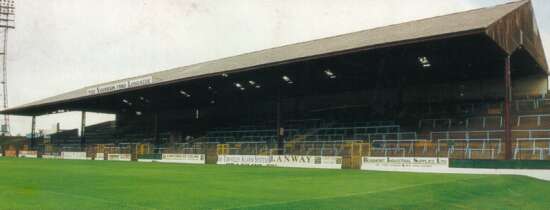|
One of the demands listed in the 22-point plan particularly interested me. A return to safe standing at football grounds, reversing a trend which has cost football millions of pounds over the past fifteen years, and saddled many clubs with crippling debt.
A generation of football fans has now grown up without knowing the famous terraces which once characterised stadiums. The North Bank at Highbury, The Kop at Anfield, The Stretford End at Old Trafford, and many other terraces at many other grounds, have been replaced by impressive new stands where people enjoy a standard of comfort that was unimaginable in those earlier times. Smart and sophisticated, many of the new stands or stadiums have become impressive icons of 1990’s architecture.
But despite all that, one of my greatest regrets as a Burnley fan is that I never stood on the Longside. I remember it, can remember some of the big games which filled it in my early days as a Claret, but back then my dad understandably preferred to take me in the Bob Lord Stand. I did watch a few games from the Bee Hole End – including, I think, the last ever game at Turf Moor where it was possible to stand – but by that time the Longside was closed, to be replaced by the giant stand which now exists.
So, like many other football supporters of my generation, I’ve learnt all I know about terraces like the Longside from my dad’s recollections, from old video clips, and books like Nick Hornby’s Fever Pitch. We know about the restricted views and the surge forwards when a goal went in. We know about the atmosphere that could be created in such an environment, and about the terrace banter and the sense of camaraderie. The trouble is, we never experienced it first hand.
There is, though, a danger of viewing terraces with rose tinted spectacles. The days of those vast, banked, terraces are, rightly, gone. They were deathtraps, dangerous and claustrophobic, an accident waiting to happen. For anyone of my age, six or seven at the time, the memories of the Hillsborough disaster are among the most powerful of their early life. Whatever the rights and wrongs of the policing that day, whatever the other factors, the structure which housed those Liverpool supporters – The Leppings Lane End – was the root cause of a horrific tragedy.
Moreover, those terraces also facilitated some of the other plagues which blighted English football in the eighties. Terraces were, for instance, a natural playground for the hooligans and thugs who infected the game at that time. Many decent football supporters stopped going to the game at that time for a variety of reasons, but there is no question that the battles which took place on the terraces played a part in driving people away.
But no-one is calling for the re-introduction of those old-style terraces. What I and many other supporters would like to see instead is the introduction of smaller, more manageable, areas of terraces. Effectively, the call is for a return to sections of terracing akin to those old-style paddocks. With proper safety limits, sub-divided sections to prevent crushing and the use of more sophisticated crowd-management techniques, it is surely possible to allow the many football fans who wish to stand to do so, without compromising safety or security in the slightest.
As the blueprint itself points out, standing is accepted at the new Arena Auf Shalke in Germany (where a 14,000 standing capacity can be converted into 6,000 seats when necessary), at Rock Concerts, and Rugby matches and Horse Racing meetings. There is no reason why those fans who wish to stand cannot do so as long as safety can be guaranteed – and these days, it absolutely can.
Football matches these days are often accused of lacking atmosphere. A constant theme amongst Burnley supporters at the moment is that the songs we sing have become limited to a few stale old numbers. It is no coincidence that it is without the spontaneity associated with terrace chanting that the atmosphere at Turf Moor and other grounds has suffered in the all-seater age.
Bringing back terracing might breath a bit of new life into our grounds. More practically, it might create a cheaper alternative to seating for clubs looking to redevelop their grounds in these cash-strapped times. The fans want it, and the technology and method is available: all that is needed is the bravery on the part of the authorities to make it happen. That will, as ever, be the biggest hurdle to overcome; it will be a long hard road to success, but with the commitment of the FSF, that road will not be impossible.

